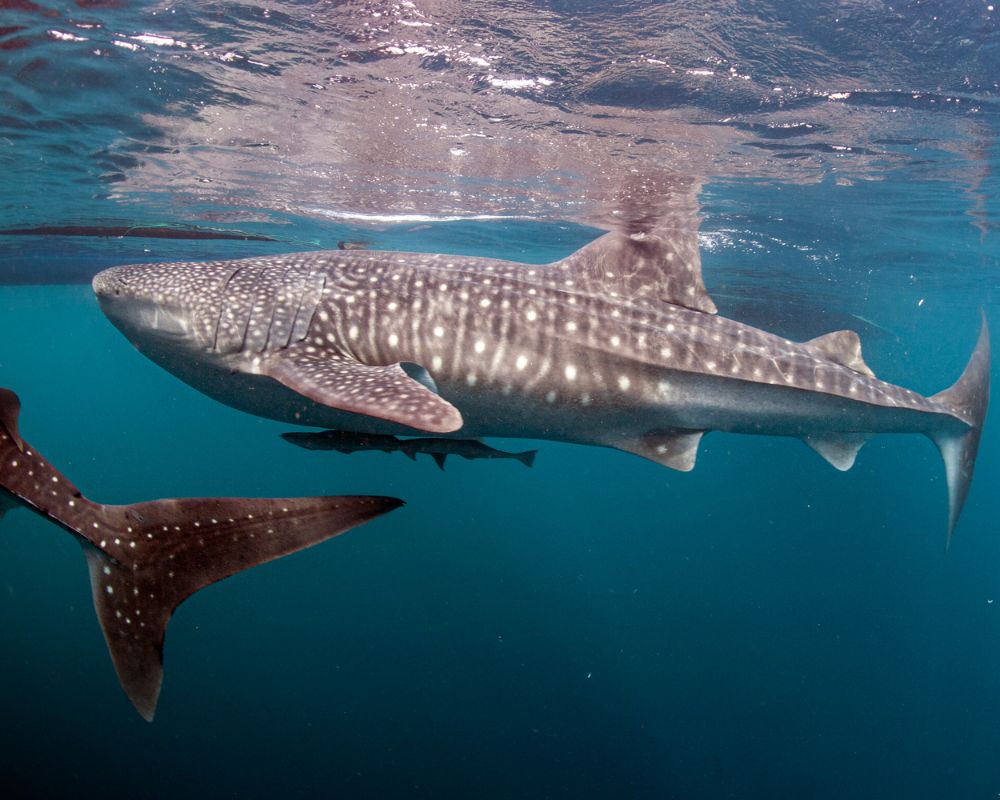Have you ever seen a creature so big, yet so gentle, that it takes your breath away? If you’ve ever been lucky enough to encounter a whale shark in the wild, you know exactly what I’m talking about.
These majestic creatures are the largest fish in the sea, reaching lengths of up to 40 feet and weighing as much as 20 tons. But what makes these gentle giants so remarkable is not just their size, but their ability to adapt to their environment.
Whale sharks have evolved a range of physical, behavioral, and environmental adaptations that allow them to thrive in their oceanic habitat. From their unique spots and specialized skin to their filter feeding and migratory patterns, every aspect of their biology is optimized for survival in the marine ecosystem.
But what exactly are these adaptations, and how do they contribute to the whale shark’s success in the wild?
In this blog post, we’ll take a closer look at how whale sharks have adapted to their environment, exploring the latest research on their physical, behavioral, and environmental adaptations.
Physical adaptations of whale sharks

Whale sharks are known for their distinctive appearance, with their spotted skin and gaping mouths. But these physical features are not just for show – they are essential adaptations that allow whale sharks to survive and thrive in their environment.
Unique Body Features
One of the most recognizable features of whale sharks is their spotted skin, which is actually a unique pattern of light-colored spots and stripes that is unique to each individual. While the exact purpose of these spots is not yet fully understood, scientists believe they may help with camouflage, communication, or temperature regulation.
Another key feature of whale sharks is their massive mouth, which can stretch up to four feet wide. This allows them to filter feed on plankton and small fish, which they capture by swimming with their mouth open and filtering out the water through their gill slits. They can consume up to 60 pounds of food in a single day.
Specialized Skin Adaptations
Whale sharks have developed specialized adaptations in their skin to protect against parasites and microbes. For example, their skin is thicker than other sharks, which helps to prevent abrasions and injuries from rough surfaces. They also have unique dermal denticles, or tooth-like structures, that reduce drag and turbulence as they swim.
In addition, scientists have discovered that whale shark skin is covered in a layer of mucus that is rich in beneficial bacteria. This “microbiome” is thought to play a key role in protecting sharks from harmful microbes, as well as aiding in digestion and other biological processes.
The physical adaptations of whale sharks are remarkable examples of how evolution has optimized their form and function for survival in the marine ecosystem.
Behavioral adaptations of whale sharks
In addition to their physical adaptations, whale sharks have also developed a range of behavioral strategies that allow them to survive and thrive in their oceanic habitat.
Filter Feeding Behavior
One of the most important behavioral adaptations of whale sharks is their filter-feeding behavior. By swimming slowly with their mouths open, they are able to filter out plankton and small fish from the water. This method of feeding allows them to consume large amounts of food efficiently while minimizing energy expenditure.
However, filter-feeding also exposes whale sharks to potential risks from consuming contaminated or toxic prey. To mitigate this risk, whale sharks have developed another behavioral adaptation – they often feed at different depths, which allows them to avoid areas with high levels of toxins and pollutants.
Migratory Patterns
Whale sharks are also known for their long-distance migrations, which can cover thousands of miles. These migrations are thought to be driven by changes in food availability, water temperature, and other environmental factors.
For example, during the summer months, whale sharks can be found in the warm, nutrient-rich waters of the western Pacific. During the winter months, they migrate to cooler waters near the equator.
To navigate these long distances, whale sharks have developed a remarkable sense of orientation. They are able to detect the Earth’s magnetic field and use it to navigate, as well as use visual cues such as the position of the sun and stars.
Social Behavior
Finally, whale sharks are also known for their social behavior. While they are generally solitary animals, they sometimes form groups or aggregations during certain times of the year.
These aggregations are thought to be driven by food availability or breeding behavior. During these times, whale sharks may engage in courtship behavior, such as swimming in circles or touching fins with each other.
The behavioral adaptations of whale sharks are an important aspect of their biology, allowing them to navigate and exploit their environment in efficient and effective ways.
Habitat and environmental adaptations of whale sharks

Whale sharks are found in warm, tropical waters around the world. They prefer areas with high plankton concentrations, such as coastal upwellings, coral reefs, and river mouths. Here are some of the habitat and environmental adaptations of whale sharks:
Temperature Regulation
As ectothermic animals, whale sharks rely on their environment to regulate their body temperature. However, even in warm waters, they can be vulnerable to sudden changes in temperature or exposure to prolonged sunlight. To regulate their body temperature, whale sharks have developed several adaptations, including:
- Countercurrent Heat Exchange: Whale sharks have a complex network of blood vessels that allows them to transfer heat from their warmer core to their cooler skin. This helps them maintain a steady body temperature, even in warm waters.
- Vertical Movement: Whale sharks are able to move between different water depths, which allows them to regulate their body temperature by either warming up or cooling down in different layers of water.
Camouflage And Protection
Whale sharks are vulnerable to predators, such as large sharks and killer whales. To protect themselves, they have developed a few adaptations:
- Camouflage: Whale sharks have a unique pattern of white spots on their skin that helps them blend in with the surrounding water and avoid detection by predators.
- Skin Thickness: The skin of whale sharks is thicker than that of most other sharks, providing some protection against bites.
- Tail Whipping: In the presence of predators, whale sharks can use their powerful tails to whip or slap their attackers, creating a distraction and potentially allowing them to escape.
Responses To Environmental Changes
Finally, whale sharks have developed adaptations to deal with environmental changes, such as changes in food availability or pollution levels. For example:
- Feeding Behavior: As mentioned earlier, whale sharks can adjust their feeding behavior to avoid areas with high levels of toxins or pollutants.
- Migration: Whale sharks can travel long distances to find suitable habitats and food sources, which can help them avoid areas with poor water quality or other environmental stressors.
Reproductive adaptations of whale sharks
Whale sharks have evolved a number of reproductive adaptations that allow them to thrive in their unique marine environment. Here are some of the ways in which they have adopted:
Timing Of Reproduction
Whale sharks are seasonal breeders, with mating and egg-laying occurring during specific times of the year. The timing of reproduction is thought to be closely linked to the availability of food, which can vary depending on location and season. By synchronizing their reproductive cycle with the availability of food, whale sharks are able to ensure the survival of their offspring.
Egg-Laying Behavior
Whale sharks are oviparous, which means they lay eggs instead of giving birth to live young. Female whale sharks lay their eggs in warm, shallow waters, where the temperature is ideal for incubation. By choosing the right location to lay their eggs, whale sharks are able to ensure the survival of their offspring.
Sperm Storage
Female whale sharks are able to store sperm for long periods of time, which allows them to fertilize their eggs even when males are not present. This adaptation is thought to be an adaptation to the migratory behavior of whale sharks, which can make finding a mate difficult. By storing sperm, female whale sharks are able to ensure successful reproduction even in the absence of a male.
Interactions with other species and their impact on adaptation
Whale sharks interact with a variety of other species in their marine environment, and these interactions have played a role in their adaptation over time. Here are some of the ways in which these interactions have impacted the evolution of whale sharks:
Symbiotic Relationships
Whale sharks have developed symbiotic relationships with a number of other species. One of the most well-known examples is their relationship with remora fish, which attach themselves to the whale shark’s body and feed on parasites and dead skin cells. This relationship benefits both species: the remora fish get a source of food, and the whale shark benefits from having its skin cleaned.
Predation
Despite their large size, whale sharks are still vulnerable to predation by larger marine predators such as sharks and killer whales. Over time, this predation pressure has likely played a role in the evolution of their physical and behavioral adaptations, such as their size, speed, and ability to sense their surroundings.
Competition For Resources
Whale sharks compete with other species for food and habitat resources. For example, they may compete with other filter-feeding species for plankton, or with other migratory species for breeding grounds. This competition has likely played a role in the evolution of their migratory behavior and their ability to adapt to changes in the availability of resources.
Human Impact
Unfortunately, human impact on the marine environment has also had an impact on whale shark adaptation. Overfishing, pollution, and habitat destruction all pose a threat to whale sharks and their habitat. Understanding these threats and working to mitigate their impact is crucial for the long-term survival of this species.
The Bottom Line
In conclusion, whale sharks have developed a range of physical, behavioral, and environmental adaptations to help them thrive in their marine environment. From their massive size and unique feeding strategies to their ability to navigate vast ocean expanses, these adaptations are a testament to the incredible resilience and adaptability of this fascinating species.
However, human impact on the marine environment poses a significant threat to their survival, making conservation efforts more crucial than ever. By understanding and appreciating these adaptations, we can work towards a future where whale sharks continue to thrive in the oceans they call home.

